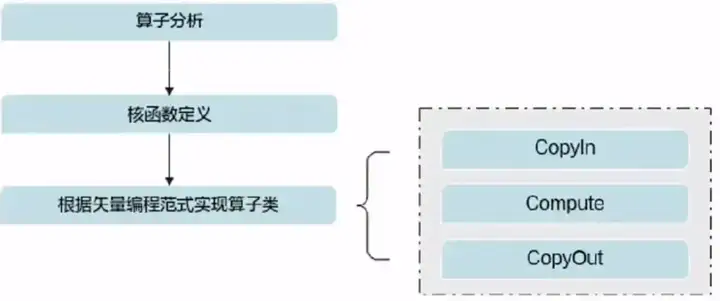摘要:简要介绍一下 akg 正反向算子的注册和关联流程。
本文分享自华为云社区《AKG 正反向算子注册 + 关联》,作者:木子_007 。
一、环境
硬件:eulerosv2r8.aarch64
mindspore:1.1
算子注册需要编译安装框架才能生效,所以默认环境中已经有了 mindspore 的源码,并且已经可以编译安装
二、正向算子制作及测试
这里制作一个计算向量平方的算子
正向:y = x**2
反向:y = 2*x
先介绍正向
2.1 定义正向算子
路径:mindspore/akg/python/akg/ms/cce/,创建 cus_square.py
参照同级目录下计算逻辑的定义,定义向量平方的计算逻辑
"""cus_square"""
from akg.tvm.hybrid import script
from akg.ops.math import mul
import akg
def CusSquare(x):
output_shape = x.shape
k = output_shape[0]
n = output_shape[1]
@script
def cus_square_compute(x):
y = output_tensor(output_shape, dtype=x.dtype)
for i in range(k):
for j in range(n):
y[i, j] = x[i, j] * x[i, j]
return y
output = cus_square_compute(x)
attrs = {
'enable_post_poly_loop_partition': False,
'enable_double_buffer': False,
'enable_feature_library': True,
'RewriteVarTensorIdx': True
}
return output, attrs然后在同级目录下的__init__.py 文件中添加内容
from .cus_square import CusSquare2.2 注册算子
到路径:mindspore/ops/_op_impl/akg/ascend,创建 cus_square.py,添加如下代码
"""CusSquare op"""
from mindspore.ops.op_info_register import op_info_register, AkgAscendRegOp, DataType as DT
op_info = AkgAscendRegOp("CusSquare") \
.fusion_type("ELEMWISE") \
.input(0, "x") \
.output(0, "output") \
.dtype_format(DT.F32_Default, DT.F32_Default) \
.get_op_info()
@op_info_register(op_info)
def _cus_square_akg():
"""CusSquare Akg register"""
return然后在同级目录的__init__.py 添加如下代码
from .cus_square import _cus_square_akg2.3 定义算子原语
到:mindspore/ops/operations,新创建一个_cus_ops.py,添加如下代码
描述算子的输入:x,输出 output
infer_shape:描述输出数据的 shape
infer_dtype:说明输出数据的类型
x1_shape:指的是第一个输入的 shape
x1_dtype:指的是第一个输入参数的 dtype
import math
from ..primitive import prim_attr_register, PrimitiveWithInfer
from ...common import dtype as mstype
from ..._checkparam import Validator as validator
from ..._checkparam import Rel
class CusSquare(PrimitiveWithInfer):
"""CusSquare"""
@prim_attr_register
def __init__(self):
self.init_prim_io_names(inputs=['x'], outputs=['output'])
def infer_shape(self, x1_shape):
return x1_shape
def infer_dtype(self, x1_dtype):
return x1_dtype然后在同目录下的__init__.py 文件中添加原语信息
from ._cus_ops import CusSquare2.4 在 ccsrc 中添加算子的查询信息
在 mindspore/ccsrc/backend/kernel_compiler/http://kernel_query.cc 的 KernelQuery 函数中添加如下信息
// cus_square
const PrimitivePtr kPrimCusSquare = std::make_shared<Primitive>("CusSquare");
if (IsPrimitiveCNode(kernel_node, kPrimCusSquare)) {
kernel_type = KernelType::AKG_KERNEL;
}2.5 编译安装框架
回到 mindspore 根目录
bash build.sh -e ascend -j4
cd ./build/package
pip install mindspore_ascend-1.1.2-cp37-cp37m-linux_aarch64.whl --force-reinstall2.6 测试
import numpy as np
import mindspore.nn as nn
import mindspore.context as context
from mindspore import Tensor
from mindspore.ops import operations as P
context.set_context(mode=context.GRAPH_MODE, device_target="Ascend")
class Net(nn.Cell):
def __init__(self):
super(Net, self).__init__()
self.square = P.CusSquare()
def construct(self, data):
return self.square(data)
def test_net():
x = np.array([[1.0, 4.0, 9.0]]).astype(np.float32)
net = Net()
output = net(Tensor(x))
print("x: ", x)
print("output: ", output)
if __name__ == "__main__":
test_net()输出
![图片[1]-带你了解 AKG 正反向算子注册 + 关联流程-开放智能](https://pic4.zhimg.com/80/v2-6cc8fbcca3bf14ed20ef6a529456631f_720w.jpg)
三、反向算子的制作和测试
3.1 制作流程
反向算子的计算逻辑:对向量元素进行求导,如 y = x^2,则求导之后 y` = 2x
实际例子就是输入向量 [1, 4, 9] 输出就是 [2, 8, 18]
反向算子明明为 CusSquareGrad,与前边的计算平方的算子流程相同,这里只贴一下关键代码,流程不再赘述
计算逻辑代码 cus_square_grad.py
"""cus_square_grad"""
from akg.tvm.hybrid import script
import akg
def CusSquareGrad(x):
output_shape = x.shape
k = output_shape[0]
n = output_shape[1]
@script
def cus_square_compute_grad(x):
y = output_tensor(output_shape, dtype=x.dtype)
for i in range(k):
for j in range(n):
y[i, j] = x[i, j] * 2
return y
output = cus_square_compute_grad(x)
attrs = {
'enable_post_poly_loop_partition': False,
'enable_double_buffer': False,
'enable_feature_library': True,
'RewriteVarTensorIdx': True
}
return output, attrs注册原语
class CusSquareGrad(PrimitiveWithInfer):
"""
CusSquareGrad
"""
@prim_attr_register
def __init__(self):
self.init_prim_io_names(inputs=['x'], outputs=['output'])
def infer_shape(self, x1_shape):
return x1_shape
def infer_dtype(self, x1_dtype):
return x1_dtype 3.2 测试
import numpy as np
import mindspore.nn as nn
import mindspore.context as context
from mindspore import Tensor
from mindspore.ops import operations as P
context.set_context(mode=context.GRAPH_MODE, device_target="Ascend")
class Net(nn.Cell):
def __init__(self):
super(Net, self).__init__()
self.square = P.CusSquareGrad() # 替换为grad算子
def construct(self, data):
return self.square(data)
def test_net():
x = np.array([[1.0, 4.0, 9.0]]).astype(np.float32)
net = Net()
output = net(Tensor(x))
print("x: ", x)
print("output: ", output)
if __name__ == "__main__":
test_net()输出
![图片[2]-带你了解 AKG 正反向算子注册 + 关联流程-开放智能](https://pic2.zhimg.com/80/v2-d97614fac2c537f838f09ea7c44b27a5_720w.jpg)
四、正反向算子关联及测试
在源码 mindspore/mindspore/ops/_grad/grad_array_ops.py 中添加如下代码
@bprop_getters.register(P.CusSquare)
def get_bprop_cussquare(self):
"""Generate bprop of CusSquare"""
cus_square_grad = P.CusSquareGrad()
matmul = ops.Mul()
def bprop(x, out, dout):
gradient = cus_square_grad(x)
dx = matmul(gradient, dout)
return (dx,)
return bpropbprop 函数的输入是,正向的输入 x,正向的输出 out,反向的梯度输入 dout
上面代码的意思是指定算子 CusSquare 的反向梯度的计算方法,CusSquareGrad 作为其中的一个函数使用
gradient = cus_square_grad (x) 计算的是本平方算子的梯度,但并不能直接返回这个梯度
反向网络到该算子,最后返回的是 dx,注意算子的反向梯度计算一定要放在整个网络的反向链式梯度计算中
测试
import numpy as np
import mindspore.nn as nn
import mindspore.context as context
from mindspore import Tensor
from mindspore.ops import operations as P
from mindspore.ops import composite as C
context.set_context(mode=context.GRAPH_MODE, device_target="Ascend")
class Net(nn.Cell):
def __init__(self):
super(Net, self).__init__()
self.square = P.CusSquare()
def construct(self, data):
return self.square(data)
def test_net():
x = Tensor(np.array([[1.0, 4.0, 9.0]]).astype(np.float32))
grad = C.GradOperation(get_all=True) # 计算网络梯度
net = Net()
output = grad(net)(x)
print("x: ", x)
print("output: ", output)
if __name__ == "__main__":
test_net()输出
![图片[3]-带你了解 AKG 正反向算子注册 + 关联流程-开放智能](https://pic3.zhimg.com/80/v2-5c9d298a75333d4e0dcd74146d1cf8a6_720w.jpg)















